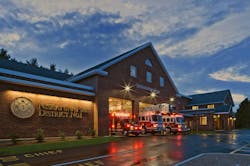The Five Pillars of Firefighter Recruitment and Retention
The National Volunteer Fire Council (NVFC) notes that 65 percent of American firefighters are volunteers and that, of the estimated 29,452 fire departments in the country, 18,873 are all volunteers and 7,794 are combination. Between 1984 and 2020, the number of volunteer firefighters dropped by 25 percent. That same period saw the number of calls triple. Departments are increasingly doing more with less. Recruitment and retention have become critical issues.
As a fire commissioner of a combination fire district, volunteer fire company member, chair of the district’s Strategic Planning Committee, and member of the department’s Recruitment and Retention Committee, I intimately understand this struggle. I also benefit from being a senior architect and director of operations at H2M architects + engineers where I’ve worked with hundreds of fire departments across North America and seen which best practices help with recruitment and retention. Armed with that information, I developed a framework of five “pillars.” Employing these within my own department has already produced meaningful results.
Pillar 1 - Awareness
Awareness is critical. Thirty years of working with fire departments has taught me that the public does not understand what you do or even that you are volunteers. When working with a department asking the public for funding for a new facility, one of the first things we task the department with is compiling a list of everything they do. Whether it’s cellar pump-outs, smoke detector installs, CPR classes, fire prevention training, technical rescue, motor vehicle accidents, EMS, building inspections, or any other response, most departments believe their citizenry already knows this. I can tell you from hundreds of public meetings that they do not. A volunteer firefighter’s drive to serve others often coincides with a lack of self-promotion, resulting in many fire departments appearing impenetrable and obscure to the average resident.
Successful departments are always finding ways to highlight what they do in the community and their need for volunteers. They cross-sell constantly. For example, the best ones not only do a great job with fire prevention activities for children, but capitalize on those events to discuss volunteering with the parents. Don’t fear the ask and look to broaden your recruitment channels to get the word out. Consider teaming with local vocational programs. I have seen one department begin to develop a program to specifically talk to trade unions and make a pitch for volunteers.
Don’t overlook platform when it comes to awareness. If you are only using flyers, websites, and Facebook, you are behind the times and not reaching an entire segment of the population that gets much of its information from YouTube, new social media, and podcasts. Ask a young adult in your life about something interesting they saw this week and you’ll inevitably find an outlet you didn’t know existed where fresh candidates await. Ultimately, recruitment starts with awareness of mission, needs, who you are, and how new people can fit into that structure.
Pillar 2 - Motivation
Why do people volunteer for a fire department? Common answers include: to give back to the community, learn a new skill, professional development, or continue a family history in the fire service. All of these motivations will help with recruitment, but how often do they come up when the conversation turns to retention? Existing volunteers still want to give back, still want to learn, still want to be part of the team. Unfulfilled motivations ruin retention as volunteers will look elsewhere to satisfy their drive to serve.
Negativity kills motivation. In an era where you’re struggling for every single volunteer, just writing somebody off doesn’t work anymore. Some volunteers may remember a time when you could say “If they want to leave, let them leave,” because there were two or three other people willing to take their place. That is no longer the case, but some people still have that mentality.
Generational differences matter. The Business Journals Leadership Trust generalizes the motivations of some of the younger generations of potential volunteers: Millennials (born 1981-1996) thrive in collaborative environments, prefer flexibility, strive for achievement, and will leave if they feel undervalued or if an organization does not align with their values. Gen Z (born 1997-2020) value social rewards such as mentorship, transparency, and frequent feedback. Your approaches for retention may differ depending upon the individual. Some departments conduct “stay surveys.” This is a great tool for understanding what motivates your particular mix of volunteers to remain or what may cause them to leave.
Recognition awards, public acknowledgements for exceptional service, and routine positive feedback are great motivators. A simple “thank you” will go a long way. Give them out liberally and sincerely to keep motivating your volunteers.
Pillar 3 - Environment
Ideally, volunteers should spend a great deal of time in the fire station. However, the physical environment of the station is often overlooked in conversations about recruitment and retention. An ideal station should be both operationally efficient and a pleasant place to be. Are there amenities that motivate volunteers to spend time in the station when they’re not actively responding to a call?
The design possibilities are endless. Common rooms can be warm and inviting with natural light and wood tones to encourage people to socialize and share knowledge. Work-from-home spaces, exercise rooms, and free laundry facilities can create an enticing environment, making it easier for volunteers and their families to spend time in the station.
A few months ago, I visited the Azores archipelago in Portugal. I saw that, at the local volunteer fire station, firefighters ate with their families every day at lunchtime on an enclosed patio. That was a lightbulb moment for me because it promotes being at the fire station. If you can be at the fire station but still be engaged with your family, you’re much more likely to not mind being at the fire station. You don’t have to choose between work and family.
The trend is to create spaces in the firehouse that encourage people to be there often, even with their families. This reduces response times, binds people together, prevents burnout, and creates an environment where it’s easier to recruit.
Pillar 4 - Culture
For volunteer firefighting to survive, we must foster a “one family” concept. We are all in it together. This is the way we act when we respond. Personality conflicts go out the window. Ironically, when we finish and get back to the firehouse, we don’t always approach culture the same way.
The NVFC’s 2020 Volunteer Retention Research Report found that the number one reported reason volunteers leave their department is a “department atmosphere full of cliques and groups that exclude others.” When considered through the perspectives of Millennial and Gen Z volunteers who highly value social interactions, cliques and “paying your dues” translate into an unpleasant work environment. New members need to feel like a valuable part of the team on day one. Younger generations of volunteers will leave if they feel excluded. Departments that I see succeeding with recruitment and retention minimize conflict, cliques, and negative behaviors. Performance or disciplinary issues are handled discretely. Negative behavior is not tolerated, and the overall culture is one of positivity and collaboration.
Pillar 5 - Structure
Are you organizing to maximize recruitment and retention? You have to look at your structure and ask, “Is this an impediment to why people might not be able to volunteer?” Innovations, such as new membership types, duty crew shifts, bunk-in programs, stipends, and flexible training options, allow more people to fit into the structure. For example, newer volunteers aren’t always able to come every Monday night to drill. If they are not available on Mondays, they simply will not volunteer. Today’s volunteers have far more structured lives and they’ve got limited availability.
My department has already enacted a number of structural changes. We applied to the state to get an exemption to the rule limiting the percent of first responders who live outside the fire district because there were untapped resources in neighboring municipalities without volunteer departments. We established new membership classes and offered ways for non-operational volunteers to contribute. We replaced the mandatory requirements to attend weekly meetings and meet certain call volumes with a duty crew model with minimum monthly hours. The goal is to increase flexibility and attract volunteers. There has been a noticeable increase in new member applications.
Conclusion
You cannot have healthy recruitment and retention without addressing all five pillars. Each is designed around improving the long-term health and longevity of volunteer fire departments and, in truth, these pillars apply equally to career departments. I have seen that firsthand. Use every resource at your disposal. One you should be aware of is FEMA’s FA-361 “Retention and Recruitment for the Volunteer Emergency Services.” Released in 2023, it contains valuable evidence-based material that supports the five pillars outlined above. The best solutions for your department should be custom-tailored to the needs of your specific community. By focusing on the five pillars, the sky’s the limit when it comes to innovating to improve recruitment and retention.
About the Author

David J. Pacheco
David J. Pacheco, AIA, NCARB is director of operations, senior architect, and senior vice president of H2M architects + engineers and was previously co-owner of a nationally recognized, award-winning architectural firm dedicated exclusively to the design of emergency response facilities across North America. Pacheco has personally designed or evaluated more than 200 fire stations, receiving accolades for his practical and aesthetically pleasing creations that respond sensitively to client needs, budget, codes, the environment, and the community.
Pacheco is licensed in 14 states and certified by the National Council of Architectural Registration Boards. He is a fire commissioner and vice-chair for Niskayuna Fire District No.1 and an active member of the Grand Boulevard Fire Co. He chairs the Strategic Planning, Installation/Inspection Dinner and Finance committees and co-chairs the Recruitment and Retention committee. He is an active member of the ASTM E54 Committee on Homeland Security Applications.
As adjunct professor at Rensselaer Polytechnic Institute, he teaches the specifics of architectural practice. He has regularly served as an instructor on firematic issues and authored/co-authored articles, books, and national standards. He has been a juror for national fire station design awards. Pacheco has cum laude degrees in both architecture and building sciences.
